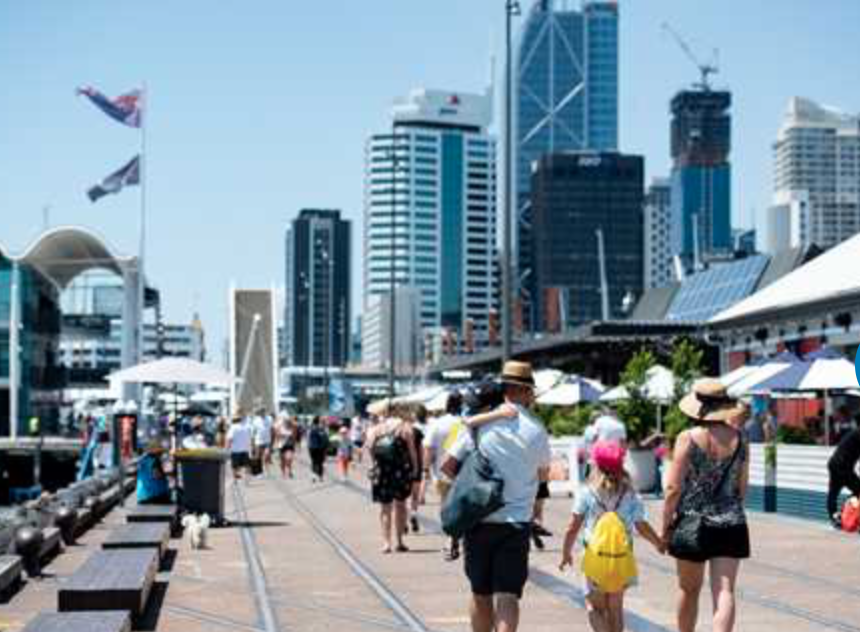One of eight Transformational Moves in the 2012 City Centre Masterplan- which was refreshed last year – the Harbour Edge Stitch, is making progress in uniting Auckland’s waterfront with the city centre.
In the wake of Emirates Team New Zealand’s victory in the 36thAmerica’s Cup, Mayor Phil Goff said it was timely to reflect on how far the area has come.
Led by Mayor Goff and councillors, a collaborative Te Kaunihera o Tāmaki Makaurau/Auckland Council group including Eke Panuku and Auckland Transport working alongside mana whenua, City Rail Link Ltd and world-class construction companies, achieved these milestones in the past year:
- America’s Cup bases
- Westhaven Promenade and Marine Village
- Amey Daldy Park
- Silo Park Extension and Wynyard Edge Alliance Major Milestones
- Galway Street shared space
- Te Komititanga
- Te Ngau o Horotiu / Ferry Basin Redevelopment
- Quay Street seismically strengthened seawall
- Te Wānanga
Mana whenua have been integral to the design and transformation of the area. Their depth of thinking and knowledge, reflected in the way the spaces look, feel and function, is ensuring the renewed Tāmaki Makaurau waterfront will be unique in the world, Mr Goff said.


“The projects completed in our city – and those that will be finished soon – are making Auckland’s city centre a more vibrant, people-friendly and environmentally attractive place to be in,” he said.
“They provide greener and healthier spaces with easier access, transforming Auckland’s waterfront into a world-class destination for Aucklanders, New Zealanders and – once our international borders reopen – for visitors from around the world.”
He said milestones Aucklanders will experience in the next six months are the opening of the restored Chief Post Office (CPO) as Britomart Transport Centre’s principal entrance in April, and openings of Quay Street enhancements and Ferry Basin Redevelopment by mid-year.
With mana whenua and other partners, the Downtown Programme team has delivered a huge-scale, high-precision and complex cluster of six projects, including critical seismic strengthening of the century-old seawall, at one of the city’s busiest convergence points, Mr Goff said.
Quay Street will be a people-focused space with a clear connection to the sea. A single lane of traffic in either direction, wide footpaths, dedicated cycleways and Te Wānanga, the new public space reaching out over the water, are expected to be eagerly anticipated by Aucklanders after two and a half years of patience.
In August, Eke Panuku celebrates the 10th anniversary of Wynyard Quarter, a signature milestone in the double decade-long transformation taking place on the glittering waterfront.
Eke Panuku’s acting GM Design & Place, Gyles Bendall says ensuring residents and visitors can move seamlessly along Auckland’s waterfront has been a key consideration in the continued evolution of this city centre neighbourhood.
“Aucklanders have a strong affinity with the sea and opening up our waterfront neighbourhoods with better and safer connections to allow access to the water’s edge has been an important part of our regeneration work,” he said.
“The recent completion of the Westhaven Promenade now offers continuous pedestrian and cycle friendly paths from the Harbour Bridge through Wynyard Quarter, adding to the connections that we are creating across the waterfront with plenty of opportunities to rest, seek shade or dip your toes in the waters of the Waitematā along the way.”
He said that together with Wynyard Edge Alliance, the infrastructure alliance created for the America’s Cup event by Auckland Council and the Crown, Eke Panuku had created a welcoming waterfront destination that would last well beyond a single sporting event, supporting the marine industry into the future.
“As well as platforms, berths and infrastructure for the syndicate bases, we’ve added additional public spaces including the new breakwaters at Wynyard Wharf and recently completed the Silo Park extension.”
“This park is the newest for Wynyard Quarter and the beginning of what will be a continuous connection up to the new public open space on Wynyard Point. Ensuring a clear cultural narrative has also been vital in all the work that we do, and we’ve worked closely with mana whenua to weave traditional stories into our work to ensure a strong Maori identity for the waterfront, one that undoubtedly makes it Auckland’s own.”
“What you see now is just the start, as the regeneration of this central city neighbourhood will continue to open up an array of exciting waterfront spaces for people to enjoy over the next two decades, aligned to the Waterfront Goals of being a public, liveable, connected, blue-green and smart working waterfront,” Mr Bendall said.








